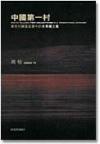
Zhou Yi 周怡
Oxford University Press, 2006
Reviewed by CHEN Xi (PhD candidate in Sociology, The Chinese University of Hong Kong)
Key Words: Huaxi village, post-collectivism, economic transformation, social integration
The success of Huaxi village in eastern China’s Jiangsu province, known as “the No.1 village under the sky”, continues to stir debate in both academic and public discourse. People are curious to know how Huaxi became such a rich village by adhering to collectivism and whether its experience can be generalized to other villages in China. Using quantitative and qualitative data, Zhou Yi examines the experience of integration, differentiation, and reintegration of Huaxi village, while coming under the influence of marketization, privatization and deconstruction of collectivism from 1961 to 2003. The book focuses on how integration is possible in a highly differentiated village context.
A key concept throughout the book, “post-collectivism” is defined as a form of community, which is a by-product of social transformation (from an agricultural society to an industrial society) and development of socio-economic systems (from planned socialism to market capitalism). The author distinguishes between “post-collectivism” and “new-collectivism”, claiming that post-collectivism is characterized by keeping collectivism at different stages of development. Like Huaxi village, even during the period when the household contract responsibility system was replacing collective economy (i.e., after the Third Plenum of the 11th Central Committee of the CCP), it still adhered to collectivism and did not change the nature of public ownership.
Why does Huaxi village remain collectivized, despite the influence of internal differentiation and challenges from the market economy? To start with, the author believes that a unique family honor and industrial integration are the logical starting points for post-collectivism. Through continuous investment in previous construction and development, villagers gain profitable return and good reputation. Therefore, a unique “family honor” is formed. This shared collective spirit has been continuously strengthened during economic development, and eventually becomes the common goal for villagers to achieve and maintain. Besides, from the perspectives of spiritual ideology, material benefits and external social capital, this collective spirit consolidates villagers’ communal identity. Thus, “industrial collectivism” becomes an inevitable choice for Huaxi.
However, differentiation begins to appear as a result of deepening industrialization and economic development. Surprisingly, this differentiation does not harm the villagers’ collective spirit. Huaxi still preserves integration and internal unity with regard to the collective goals, factors of community change, the income distribution system and interpersonal orientation. There are several reasons that account for the integration in a context of high differentiation. First, habit as well as village regulations and non-governmental agreements constitute the basis for the integration of the village. These non-official agreements not only help villagers gain spiritual satisfaction and material benefits, but also act as a way of informal control that forces villagers to integrate into the community. Second, family politics play a key role in the development of Huaxi. The replacement of the original “collectivist village politics” by family politics occurred after Wu Renbao took the leadership. Wu enjoyed “charismatic authority” because he made huge contribution to the economic development of Huaxi village but he was detached from material interests. His ability and personal charisma were among the most important reasons why Huaxi villagers are full of confidence and hold high expectation toward collectivism.
The book is well written with a profound theoretical framework, rich data, and a clear narrative. However, the book invites questions that go unanswered. First, what is the relationship between social integration and post-collectivism? The author focuses on the integration of Huaxi village, while the meaning of post-collectivism is beyond it. Second, what is the key difference between post-collectivism and new collectivism? The author could make comparisons between the two forms of collectivism and clarify the special features of post-collectivism. Last but not least, since most villages in China have experienced the allocation of land to farmers (new collectivism), Huaxi village appears as a rather special case. Thus, it would be worth considering the key question to what extent the study of post-collectivism of Huaxi village can be generalized to other villages in China, as well as in the world.
